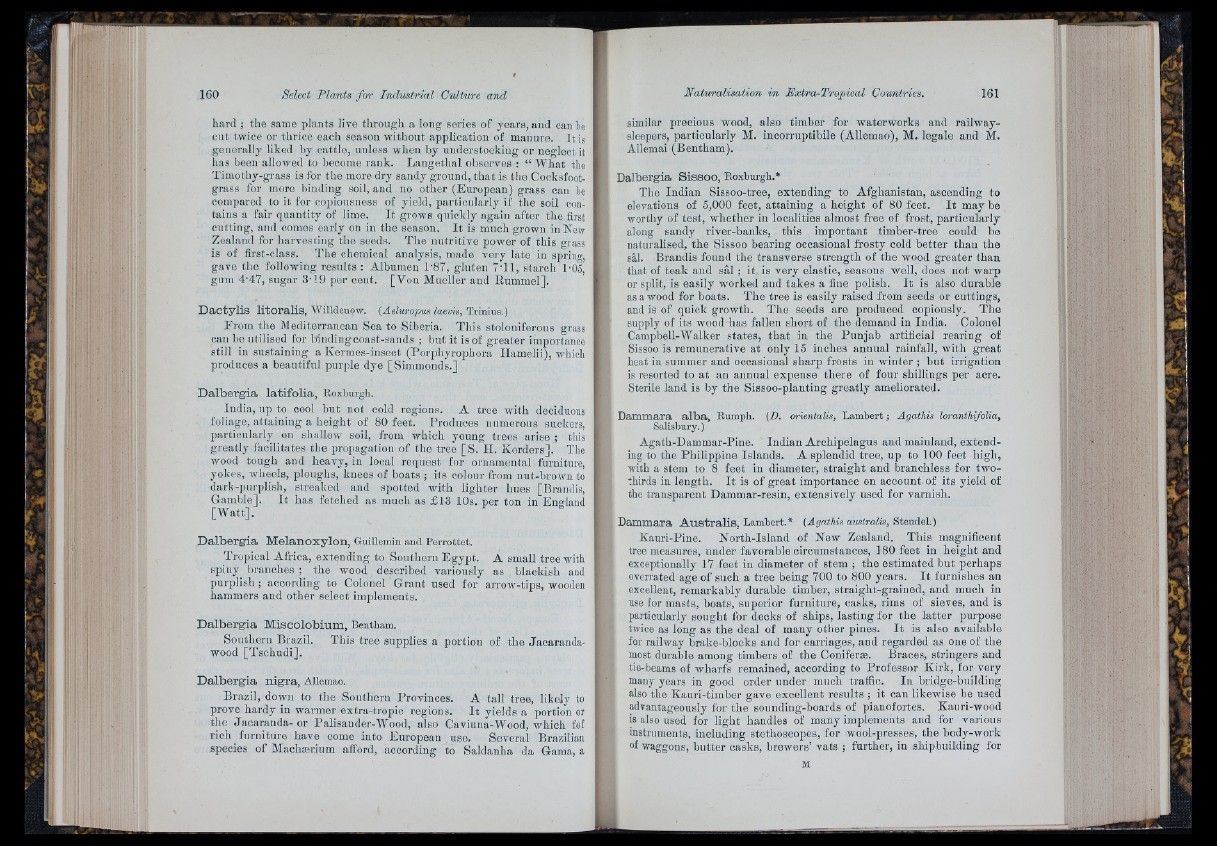
hard ; the same plants live through a long series of years, and can he
cut twice or thrice each season without application of manure. It is
generally liked by cattle, unless when by understocking or neglect it
has been allowed to become rank. Langethal observes : “ What the
Timothy-grass is for the more dry sandy ground, th a t is the Cocksfoot-
grass for more binding soil, and no other (European) grass can be
compared to it for copiousness of yield, particularly if the soil contains
a fair quantity of lime. I t grows quickly again after tlie first
cutting, and comes early on in the season. I t is much grown iuNew
Zealand for harvesting the seeds. The nutritive power of this grass
is of first-class. The ehemioal analysis, made very late in spring,
gave the following results : Albumen 1'87, gluten 7T1, starch l-Oo,
gum 4-47, sugar 3'19 por cent. [Von Mueller and Rummel].
D a c ty lis lito r a lis , Willdenow. (Aeluropus laevis, Trinins.)
From the Mediterranean Sea to Siberia. This stoloniferoiis grass
can be utilised for binding coast-sands ; but it is of greater importance
still in sustaining a Kermes-insect (Porphyrophora Hamelii), which
produces a beautiful purple dye [Simmonds.]
D a lb e rg ia la tifo lia , Roxburgh.
India, up to cool but not cold regions. A tree with deciduous
foliage, attaining a height of 80 feet. Produces numerous suckers,
particularly on sliallow soil, from which young trees arise ; this
greatly facilitates the propagation of the tree [S. H. Korders], The
w'Ood tough and heavy, in local request for ornamental furniture,
yokes, wheels, ploughs, knees of boats ; ils colour from nut-brown to
dark-purplish, streaked and spotted with lighter hues [Brandis,
Gamble]. I t has fetched as much as £13 10s. por ton in Enaland
[W a tt].
D a lb e rg ia M e la n o x y lo n , Guillemin and Perrottet.
Tropical Africa, extending to Sonthern Egypt. A small tree with
spiny branches ; the wood described variously as blackish and
purplish ; according to Colonel Grant used for arrow-tips, wooden
hammers aud other select implements.
D a lb e rg ia M is c o lo b ium , Bentham.
Southern Brazil. This tree supplies a portion of the Jacaranda-
wood [Tschudi],
D a lb e rg ia n ig ra , Allemao.
Brazil, down to the Southern Provinces. A tall tree, likely to
prove hardy in warmer extra-tropio regions. I t yields a portion or
the Ja carau d a-o r Palisander-Wood, also Caviuna-Wood, which fof
ricli furniture have eome into European use. Several Brazilian
species of Machmrium afford, according to Saldanha da Gama, a
similar precious wood, also timber for waterworks and railway-
sleepers, particularly M. incorruptibile (Allemao), M. legale aud M.
Allemai (Bentham).
Dalbergia Sisso o , Roxburgh.*
The Indian Sissoo-tree, extending to Afghanistan, ascending to
elevations of 5,000 feet, attaining a height of 80 feet. I t may be
worthy of test, whether iu localities almost free of frost, particularly
along sandy river-banks, this important timber-tree could be
naturalised, the Sissoo bearing occasional frosty cold better than the
sal. Brandis found the transverse strength of the wood greater than
that of teak and sal ; it is very elastic, seasons well, does not warp
or split, is easily worked and takes a fine polish. I t is also durable
as a wood for boats. The tree is easily raised from seeds or cuttings,
and is of quick growth. The seeds are produced copiously. The
supply of its wood has fallen short of the demand in India. Colonel
Campbell-Walker states, th a t in the Punjab artificial rearing of
Sissoo is remunerative at only 15 inches annual rainfall, with great
heat in summer and occasional sharp frosts in winter ; but irrigation
is resorted to a t an annual expense there of four shillings per acre.
Sterile land is by the Sissoo-planting greatly ameliorated.
Daniniara a lb a , Rumph. {D. orientalis, Lambert ; Agathis loranthifolia,
Salisbury. )
Agath-Dammar-Pine. Indian Archipelagus and mainland, extending
to the Philippine Islands. A splendid tree, up to 100 feet high,
with a stem to 8 feet in diameter, straight and branchless for two-
thirds in length. I t is of great importance on account of its yield of
the transparent Dammar-resin, extensively used for varnish.
Dam m a ra A u s t r a l i s , Lambert.* (AjruiAis ««siraiis, Steudel.)
Kanri-Pine. North-Island of New Zealand. This magnificent
tree measures, under favorable circumstances, 180 feet in height and
exceptionally 17 feet in diameter of stem ; the estimated but perhaps
overrated age of such a tree being 700 to 800 years. I t furnishes an
excellent, remarkably durable timber, straight-grained, aud much in
use for masts, boats, superior furniture, casks, rims of sieves, and is
particularly sought for decks of ships, lasting for the latter purpose
twice as long as the deal of many otlier pines. I t is also available
for railway brake-blocks and for carriages, and regarded as one of the
most durable among timbers of the Coniferas. Braces, stringers and
tie-beams of wharfs remained, according to Professor Kirk, for very
many years in good order under much traffic. In bridge-building
also the Kauri-timber gave excellent results ; it can likewise be used
advantageously for the sounding-boards of pianofortes. Kauri-wood
is also used for liglit handles of many implements and for various
instruments, including stethoscopes, for wool-presses, the body-work
of waggons, butter casks, brewers’ vats ; further, iu sliipbnilding for